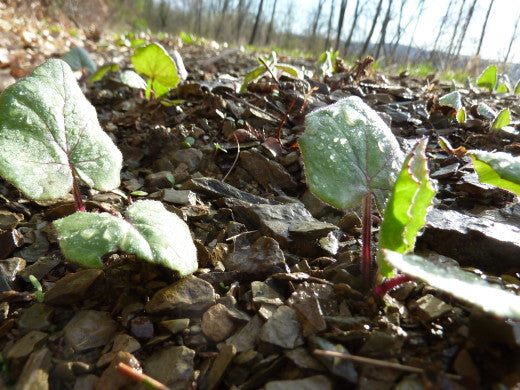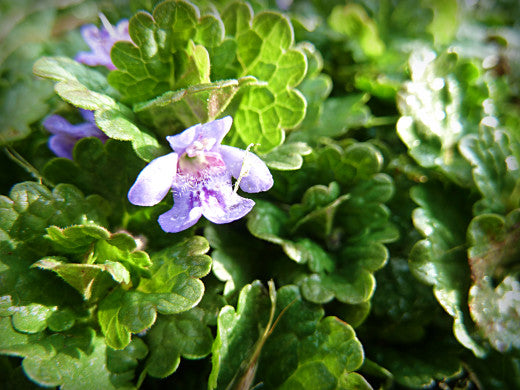Backyard Survival Herbs- Springing Up Everywhere!

As things start popping out all over, we want to take a look at some natural herbs that you can collect right around the areas you frequent - whether it be a rural plot of land or a park nearby to a more urban area. It's amazing how many plants we crush under our feet can actually be useful and there are some that are specifically at their peak in the spring season. Ahhhhh.....the smell of soft earth, thawed of the permafrost and ready for new growth! There might be mud under our feet, but there's a song in the air as the birds return and remind us that new life is on the way! Spring is most definitely my favorite season - nature's rendition of chartreuse leaves against a clear blue sky is unparalleled in positive mood enhancement capabilities - it's just beyond beautiful! And to me, nothing is more amazing than the way we are provided for through the plants that grow without our even trying. Let's look at some herbs aka weeds that you can start to scour the land for during the beginning of a new year of growth.
Coltsfoot 
I start with this one because it is my favorite "sign of spring" to come upon the small dandelion-like heads of coltsfoot flowers blooming. This plant is unique in that you use the dried flowers and hoof-shaped leaves, but you can't harvest both at the same time. First the flowers bloom on their stems and then drop seeds, after which a cluster of the leaves will spring up sans flowers. So, first flowers, then leaves.

Tussilago farfara is a controversially useful herb. Because of its chemical makeup, it is deemed very dangerous for pregnant and nursing women or babies to use. It was banned in Germany because of the toxicity to the liver of the pyrrolizidine alkaloids it contains. The level is just too high for babies. There is a strain of coltsfoot that has been developed, the Wein strain, that has eliminated these alkaloids. and enables the tea to be drunk safely. Coltsfoot combines a soothing expectorant effect with an anti-spasmodic action. The first part of its Latin name, Tussilago, means cough, which explains its original common name, coughwort, in its native Europe. Since the days of ancient Greece and Rome, coltsfoot has been eaten drunk and even smoked to relieve congestion and break up and expel mucus. The leaves contain useful levels of zinc, a mineral which can have an anti-inflammatory effect, which can help prevent airway constriction for asthmatics.. It can also bring comfort to someone wracked by chronic emphysema. So coltfsoot is an herb you might want to pull out in cases of bronchitis, whooping cough or other coughs, and asthma. To use coltsfoot,(Again, be very careful to research this herb on your own and do not use it with very young children or pregnant and nursing moms.) dry the flowers and leaves in the shade, gathering the flowers before they are fully bloomed and collecting the leaves between late spring and early summer. Chop them up before drying and storing for tea. This herb can be partnered very effectively with mullein for coughs. You could also make cough lozenges. A recipe for lozenges might look something like this: 4 cups coltsfoot leaves 2 1/2 cups water scant 2 cups sugar scant 2 cups golden syrup 3 Tbs. butter 1/2 tsp baking soda Boil the washed coltsfoot leaves in the water and drain off the liquid. Put the sugar, golden syrup and butter in a pan and add the herb liquid. Bring to a boil, stirring and continue boiling until a drop of the mixture turns brittle when dropped into a bowl of cold water. Remove from heat and add the baking soda, beating very well as it foams up, until almost stiff. Pour into a greased shallow pan. Allow to set and then crack into pieces for lozenges. Store in a glass jar.
Self-heal 
The common name of prunella vulgaris suggests one of its main functions: the ability to heal wounds. The fresh leaves can be used or a poultice or compress made to aid in the clean healing of cuts and wounds. The aerial parts are antioxidant, diuretic and antibacterial. Supposedly, crushing the young aerial parts to extract juice and rubbing the juice on the source location of a headache will help relieve it. You'll want to learn what the plant looks like, then go out and collect the young shoots and leaves before they blossom. Dry and then use an an infusion, gargle or lotion. The infusion will help soothe inflammation associated with diarrhea. The gargle will help soothe and heal a sore throat and laryngitis. You can make an ointment or cream to relieve hemorrhoidal pain and itching. To make an ointment, combine 1 part of the powdered leaves with 4 parts of petroleum jelly, softened lard or paraffin or melted beeswax,etc. This can be stored up to 3 months.

To make a cream, you'll need a nice digital scale that can measure out grams. Combine 30g (~1 oz.)dried or 75g (~2.7 oz) fresh herb with 150g (~5.3 oz) emulsifying wax, melted, 70g(2.5oz.) glycerine and 80ml(~1/3 cup) water. Strain mixture through a fine cloth or coffee filter. Stir constantly until the mixture is cool. Transfer to small jars, seal and label. 5ml of borax or a few drops of friar's balsam (tincture of benzoin) added to the mixture will extend shelf life. Storage time is about 3 months. Rub cream onto affected area 2-3 times a day. The tea can be used as a general pick-me-up and has a gentle astringent aspect. You can squeeze the fresh juice into some hot water or soak the dried herb for about 10 minutes. It also helps reduce blood pressure, so be wise to not drink this tea if you have very low blood pressure.
Ground Ivy 
Ground ivy, glechoma hederacea, a member of the mint family, is a delicate herb in both features and function. It looks similar to a couple of other weeds, with its clusters of trumpeting lavender blossoms and fan-shaped leaves with round-toothed edges, but it can be distinguished from those by its square, creeping stems that root at the nodes and the mint odor emitted when the leaves-which are hairy on top- are crushed. Ground ivy is suited best as an amplification to other herbs, like coltsfoot and golden rod. It is an herb that can be used in the treatment of either chest or sinus catarrh and when combined with other herbs, as mentioned above, aids in the healing of coughs and bronchitis. It is especially helpful when ears get so clogged that they are ringing. (tinnitis) Being a bit astringent, it can also aid in cases of diarrhea , hemorrhoids or cystitis. Look for the flowering stems and collect them between mid-spring and summer. Again, dry them and store. You can then use the herb in conjunction with others in teas. Used fresh, it can be a delightful addition to a wildcrafted salad. A last note of interest is that this herb must have some fermenting properties as it can be used as a substitute for rennet in cheesemaking and it is reported to have been used by the Saxons in making a brewed ale before hops was discovered and implemented. It is also noted with cautions in some manuals due to the presence of terpenoids, which can harm the liver and cause abortions, and irritate the GI tract. The levels of these terpenoids is very slight, however, which would account for this plant's popularity for centuries.

Enjoy the discovery of what is springing up at your feet!
Disclaimer: Of course we claim no responsibility for your experience with these herbs. Everything we share is for information purposes only and is not to be taken as professional or medical advice. Do your own research! Always consult a professional. Be wise. Consider always the chance of an allergic reaction. We are all unique in body chemistry. We are NOT a medical professionals by any means, however we have saved our family a boatload of annoyance and money by being resourceful and using what is right at our feet – literally. See full disclaimer here.




Leave a comment